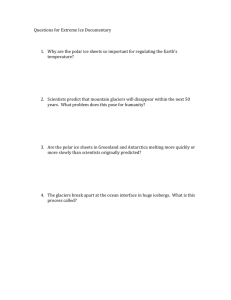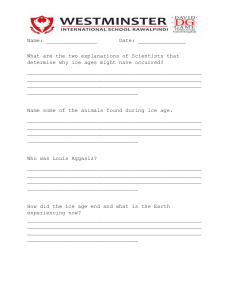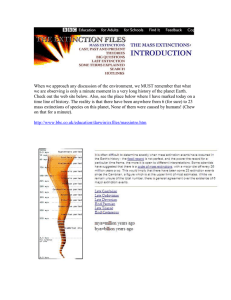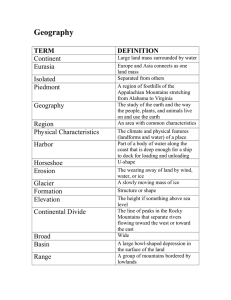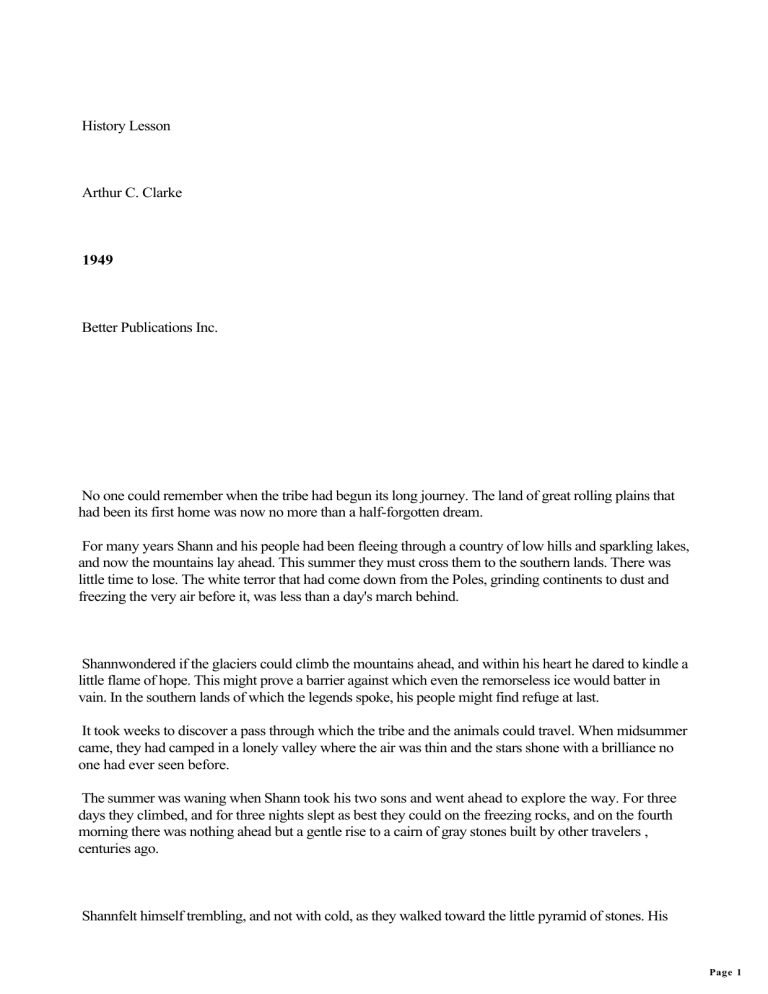
History Lesson Arthur C. Clarke 1949 Better Publications Inc. No one could remember when the tribe had begun its long journey. The land of great rolling plains that had been its first home was now no more than a half-forgotten dream. For many years Shann and his people had been fleeing through a country of low hills and sparkling lakes, and now the mountains lay ahead. This summer they must cross them to the southern lands. There was little time to lose. The white terror that had come down from the Poles, grinding continents to dust and freezing the very air before it, was less than a day's march behind. Shannwondered if the glaciers could climb the mountains ahead, and within his heart he dared to kindle a little flame of hope. This might prove a barrier against which even the remorseless ice would batter in vain. In the southern lands of which the legends spoke, his people might find refuge at last. It took weeks to discover a pass through which the tribe and the animals could travel. When midsummer came, they had camped in a lonely valley where the air was thin and the stars shone with a brilliance no one had ever seen before. The summer was waning when Shann took his two sons and went ahead to explore the way. For three days they climbed, and for three nights slept as best they could on the freezing rocks, and on the fourth morning there was nothing ahead but a gentle rise to a cairn of gray stones built by other travelers , centuries ago. Shannfelt himself trembling, and not with cold, as they walked toward the little pyramid of stones. His Page 1 sons had fallen behind. No one spoke, for too much was at stake. In a little while they would know if all their hopes had been betrayed. To east and west, the wall of mountains curved away as if embracing the land beneath. Below lay endless miles of undulating plain, with a great riverswinging across it in tremendous loops. It was a fertile land; one in which the tribe could raise crops knowing that there would be no need to flee before the harvest came. Then Shann lifted his eyes to the south, and saw the doom of all his hopes. For there at the edge of the world glimmered that deadly light he had seen so often to the north-the glint of ice below the horizon. There was no way forward. Through all the years of flight, the glaciers from the south had been advancing to meet them. Soon they would be crushed beneath the moving walls of ice . . . Southern glaciers did not reach the mountains until a generation later. In that last summer the sons of Shann carried the sacred treasures of the tribe to the lonely cairn overlooking the plain. The ice that had once gleamed below the horizon was now almost at their feet. By spring it would be splintering against the mountain walls. No one understood the treasures now. They were from a past too distant for the understanding of any man alive. Their origins were lost in the mists that surrounded the Golden Age, and how they had come at last into the possession of this wandering tribe was a story that now would never be told.For it was the story of a civilization that had passed beyond recall. Once, all these pitiful relics had been treasured for some good reason, and now they had become sacred though their meaning had long been lost. The print in the old books had faded centuries ago though much of the lettering was still visible-if there had been any to read it. But many generations had passed since anyone had had a use for a set of seven-figure logarithms, an atlas of the world, and the score of Sibelius ' Seventh Symphony printed, according to the flyleaf, by H. K. Chu and Sons, at the City of Pekin in the year 2371 A.D. The old books were placed reverently in the little crypt that had been made to receive them. There followed a motley collection of fragments-gold and platinum coins, a broken telephoto lens, a watch, a cold-light lamp, a microphone, the cutter from an electric razor, some midget radio tubes, the flotsam that had been left behind when the great tide of civilization had ebbed forever. All these treasures were carefully stowed away in their resting place.Then came three more relics, the most sacred of all because the least understood. The first was a strangely shaped piece of metal, showing the coloration of intense heat. It was, in its way, the most pathetic of all these, symbols from the past, for it told of man's greatest achievement and of the future he might have known. The mahogany stand on which it was mounted bore a silver plate with the inscription: Page 2 Auxiliary Igniter from Starboard Jet Spaceship "Morning Star" Earth-Moon, A.D. 1985 Next followed another miracle of the ancient science-a sphere of transparent plastic with strangely shaped pieces of metal imbedded in it.At its center was a tiny capsule of synthetic radio element, surrounded by the converting screens that shifted its radiation far down the spectrum. As long as the material remained active, the sphere would be a tiny radio transmitter, broadcasting power in all directions. Only a few of these spheres had ever been made.-They had been designed as perpetual beacons to mark the orbits of the asteroids. But man had never reached the asteroids and the beacons had never been used. Last of all was a flat, circular tin, wide in comparison with its depth. It was heavilysealed, and rattled when shaken. The tribal lore predicted that disaster would follow if it was ever opened, and no one knew that it held one of the great works of art of nearly a thousand years before. The work was finished. The two men rolled the stones back into place and slowly began to descend the mountainside. Even to the last, man had given some thought to the future and had tried to preserve something for posterity. That winter the great waves of ice began their first assault on the mountains, attacking from north and south. The foothills were overwhelmed in the first onslaught, and the glaciers ground them into dust. But the mountains stood firm,and )When the summer came the ice retreated for a while. So, winter after winter, the battle continued, and the roar of the avalanches, the grinding of rock and the explosions of splintering ice filled the air with tumult. No war of man's had been fiercer than this, and even man's battles had not quite engulfed the globe as this had done. At last the tidal waves of ice began to subside and to creep slowly down the flanks of the mountains they had never quite subdued. The valleys and passes were still firmly in their grip. It was stalemate. The glaciers had met their match, but their defeat was too late to be of any use to man. So the centuries passed, and presently there happened something that must occur once at least in the history of every world in the universe, no matter how remote and lonely it may be. The ship from Venus came five thousand years too late, but its crew knew nothing of this.While still many millions of miles away, the telescopes had seen the great shroud of ice that made Earth the most brilliant object in the sky next to the sun itself. Here and there the dazzling sheet was marred by black specks that revealed the presence of almost buried mountains. That was all. The rolling oceans, the plains and forests, the deserts and lakes -all that had been the world of man was sealed beneath the ice, perhaps forever. The ship closed in to Earth and established an orbit less than a thousand miles away. For five days it circled the planet, while cameras recorded all that was left to see and a hundred instruments gathered information that would give the Venusian scientists many years of work. Page 3 An actual landing was not intended. There seemed little purpose in it. But on the sixth day the picture changed. A panoramic monitor, driven to the limit of its amplification, detected the dying radiation of the five-thousand-year-old beacon. Through all the centuries, it had been sending out its signals with ever-failing strength as its radioactive heart steadily weakened. The monitor locked on the beacon frequency. In the control room, a bell clamored for attention. A little later, the Venusian ship broke free from its orbit and slanted down toward Earth, toward a range of mountains that still towered proudly above the ice, and to a cairn of gray stones that the years had scarcely touched . . . . The great disk of the sun blazed fiercely in a sky no longer veiled with mist, for the clouds that had once hidden Venus had now completely gone. Whatever force had caused the change in the sun's radiation had doomed one civilization, but had given birth to another. Less than five thousand years before, the half-savage people of Venus had seen sun and stars for the first time. Just as the science of Earth had begun with astronomy, so had that of Venus, and on the warm, rich world that man had never seen progress had been incredibly rapid. Perhaps the Venusians had been lucky. They never knew the Dark Age that held man enchained for a thousand years. They missed the long detour into chemistry and mechanics but came at once to the more fundamental laws of radiation physics. In the time that man had taken to progress from the Pyramids to the rocket-propelled spaceship, the Venusians had passed from the discovery of agriculture to antigravity itself-the ultimate secret that man had never learned. The warm ocean that still bore most of the young planet's life rolled its breakers languidly against the sandy shore. So new was this continent that the very sands were coarse and gritty. There had not yet been time enough for the sea to wear them smooth. The scientists lay half in the water, their beautiful reptilian bodies gleaming in the sunlight. The greatest minds of Venus had gathered on this shore from all the islands of the planet. What they were going to hear they did not know, except that it concerned the Third World and the mysterious race that had peopled it before the coming of the ice. . The Historian was standing on the land, for the instruments he wished to use had no love of water. By his side was a large machine which attracted many curious glances from his colleagues. It was clearly concerned with optics, for a lens system projected from it toward a screen of white material a dozen yards away. The Historian began to speak. Briefly he recapitulated what little had been discovered concerning the Third Planet and its people. Page 4 He mentioned the centuries of fruitless research that had failed to interpret a single word of the writings of Earth. The planet had been inhabited by a race of great technical ability. That, at least, was proved by the few pieces of machinery that had been found in the cairn upon the mountain. "We do not know why so advanced a civilization came to an end," he observed. "Almost certainly, it had sufficient knowledge to survive an ice Age. There must have been some other factor of which we know nothing. Possibly disease or racial degeneration may have been responsible. It has even been suggested that the tribal conflicts endemic to our own species in prehistoric times may have continued on the Third Planet after the coming of technology. "Some philosophers maintain that knowledge of machinery does not necessarily imply a high degree of civilization, and it is theoretically possible to have wars in a society possessing mechanical power, flight, and even radio. Such a conception is alien to our thoughts, but we must admit its possibility. It would certainly account for the downfall of the lost race. "ithas always been assumed that we should never know anything of the physical form of the creatures who lived on Planet Three. For centuries our artists have been depicting scenes from the history of the dead world, peopling it with all manner of fantastic beings. Most of these creations have resembled us more or less closely, though it has often been pointed out that because we are reptiles it does not follow that all intelligent life must necessarily be reptilian. "We now know the answer to one of the most baffling problems of history. At last, after hundreds of years of research, we have discovered the exact form and nature of the ruling life on the Third Planet." There was a murmur of astonishment from the assembled scientists. Some were so taken aback that they disappeared for a while into the comfort of the ocean, as all Venusians were apt to do in moments of stress. The Historian waited until his colleagues reemerged into the element they so disliked. He himself was quite comfortable, thanks to the tiny sprays that were continually playing over his body. With their help he could live on land for many hours before having to return to the ocean. The excitement slowly subsided and the lecturer continued: "One of the most puzzling of the objects found on Planet Three was a flat metal container holding a great length of transparent plastic material, perforated at the edges and wound tightly into a spool. This transparent tape at first seemed quite featureless, but an examination with the new subelectronic microscope has shown that this is not the case. Along the surface of the material, invisible to our eyes but perfectly clear under the correct radiation, are literally thousands of tiny pictures. It is believed that they were imprinted on the material by some chemical means, and have faded with the passage of time. "These pictures apparently form a record of life as it was on the Third Planet at the height of its civilization. They are not independent. Consecutive pictures are almost identical, differing only in the detail of movement. The purpose of such a record is obvious. It is only necessary to project the scenes in rapid succession to give an illusion of continuous movement. We have made a machine to do this, and I have Page 5 here an exact reproduction of the picture sequence. "The scenes you are now going to witness take us back many thousands of years, to the great days of our sister planet. They show a complex civilization, many of whose activities we can only dimly understand. Life seems to have been very violent and energetic, and much that you will see is quite baffling. "It is clear that the Third Planet was inhabited by a number of different species, none of them reptilian. That is a blow to our pride, but the conclusion is inescapable. The dominant type of life appears to have been a two-armed biped. It walked upright and covered its body with some flexible material, possibly for protection against the cold, since even before the Ice Age the planet was at a much lower temperature than our own world. But I will not try your patience any further. You will now see the record of which I have been speaking." A brilliant light flashed from the projector. There was a gentle whirring, and on the screen appeared hundreds of strange beings moving rather jerkily to and fro. The picture expanded to embrace one of the creatures, and the scientists could see that the Historian's description had been correct. The creature possessed two eyes, set rather close together, but the other facial adornments were a little obscure. There was a large orifice in the lower portion of the head that was continually opening and closing. Possibly it had something to do with the creature's breathing. The scientists watched spellbound as the strange being became involved in a series of fantastic adventures. There was an incredibly violent conflict with another, slightly different creature. It seemed certainthat they must both be killed, but when it was all over neither seemed any the worse. Thencame a furious drive over miles of country in a four wheeled mechanical device which was capable of extraordinary feats of locomotion. The ride ended in a city packed with other vehicles moving in all directions at breathtaking speeds. No one was surprised to see two of the machines meet head-on with devastating results. After that, events became even more complicated. It was now quite obvious that it would take many years of research to analyze and understand all that was happening. It was also clear that the record was a work of art, somewhat stylized, rather than an exact reproduction of life as it actually had been on the Third Planet. Most of the scientists felt themselves completely dazed when the sequence of pictures came to an end. There was a final flurry of motion, in which the creature that had been the center of interest became involved in some tremendous but incomprehensible catastrophe. The picture contracted to a circle, centered on the creature's head. The last scene of all was an expanded view of its face, obviously expressing some powerful emotion. But whether it was rage, grief, defiance, resignation or some other feeling could not be guessed. The picture vanished. For a moment some lettering appeared on the screen,then it was all over. Page 6 For several minutes there was complete silence, save for the lapping of the waves upon the sand. The scientists were too stunned to speak. The fleeting glimpse of Earth's civilization had had a shattering effect on their minds. Then little groups began to start talking together, first in whispers and then more and more loudly as the implications of what they had seen became clearer. Presently the Historian called for attention and addressed the meeting again. "We are now planning," he said, "a vast program of research to extract all available knowledge from this record. Thousands of copies are being made for distribution to all workers. You win appreciate the problems involved. The psychologists in particular have an immense task confronting them. "But I do not doubt that we shall succeed. In another generation, who can say what we may not have learned of this wonderful race? Before we leave, let us look again at our remote cousins, whosewisdom may have surpassed our own but of whom so little has survived." Once more the final picture flashed on the screen, motionless this time, for the projector had been stopped. With something like awe, the scientists gazed at the stiff figure from the past, while in turn the little biped stared back at them with its characteristic expression of arrogant bad temper. For the rest of time it would symbolize the human race. The psychologists of Venus would analyze its actions and watchits every movement until they could reconstruct its mind. Thousands of books would be written about it. Intricate philosophies would be contrived to account for its behavior . But all.this labor, all this research, would be utterly in vain. Perhaps the proud and lonely figure on the screen was smiling sardonically at the scientists who were starting on their age-long fruitless quest. Its secret would be safe as long as the universe endured, for no one now would ever read the lost language of Earth. Millions of times in the ages to come those last few words would flash across the screen, and none could ever guess their meaning: ............................A Walt Disney Production. Page 7

